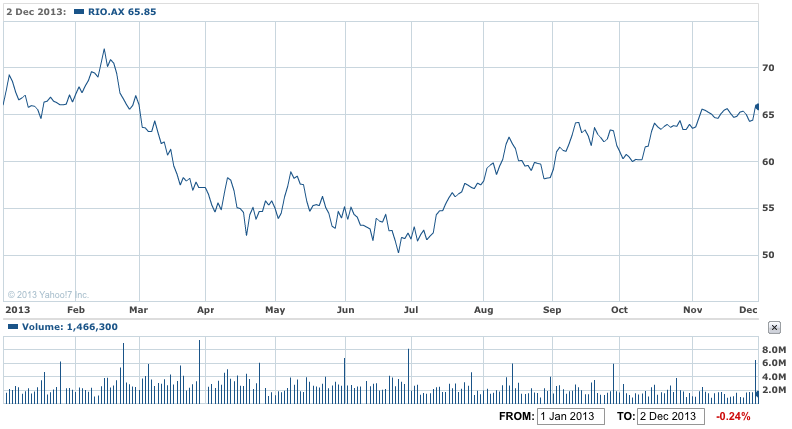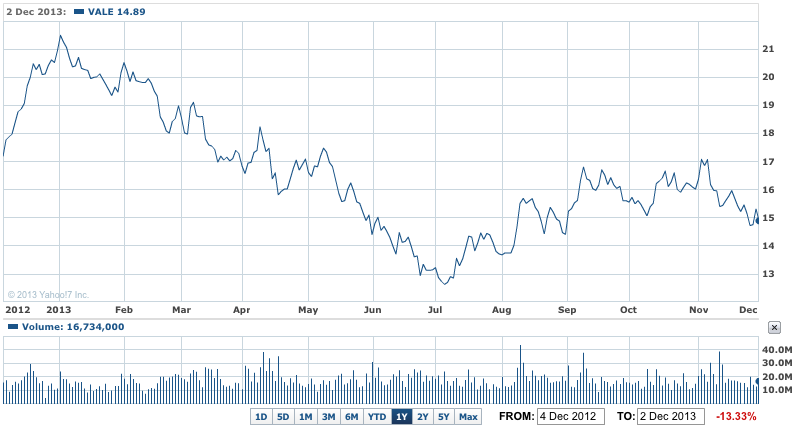Rio Tinto (RIO) and Vale of Brazil are the world’s second biggest and third biggest miners by market value – but a year or so ago, Vale was second and Rio was third.
Rio has overtaken Vale because investors believe its cost-cutting mantra more than they do the line from the Brazilian giant.
Both have been forced to slash spending on new and existing projects, cut staff and other costs because of the slowdown in demand and rising overproduction.
This week has seen major statements from both miners where they outlined their new, deeper spending cuts.
Vale announced its new plan on Monday night, our time, Rio Tinto issued its new plan yesterday.
That plan saw more hair-shirted talk from Rio Tinto yesterday about how it’s still on its abstemious path of cutting spending and maxmising returns to shareholders.
In comments made at an investor day presentation, the company confirmed that capital investment would again fall sharply in 2014 and 2015.
It was exactly the message that the assembled audience of investors and brokers wanted to hear.
But it was always on the cards after the miner revealed last Thursday that it had cut $US3 billion from its $US5 billion iron ore expansion plan.
The company said 2014 capital spending will fall to $US11 billion and to $US8 billion in 2015.
This compares with outlays for 2014 of "below $US14 billion", down 20% from 2012.
"We continue to see market fragility and volatility,” the group’s chief executive Sam Walsh said.
"The impacts of decisions like quantitative easing and austerity programs are still washing through markets around the world."
Even so, the group said the outlook remains "robust", due to continued urbanisation in China, along with anticipated strong growth in other countries such as India and Vietnam.
Rio Tinto said it had cut operating costs by $US1.8 billion in the 10 months to October and was on target to meet the projected $US2 billion figure by the end of this month.
Exploration and evaluation spend in the 10 months to October has been cut by $US800 million, more than the 2013 target of $US750 million.
Rio said that it had sold non core assets valued at $US3.3 billion of divestments this year, proceeds of $US2.3 billion already received.
The sale of Northparkes copper mine in NSW was completed on Sunday of this week for final cash proceeds of $US820 million.
The sale of the Clermont coal mine in Queensland is on track to be finalised early in the New Year.
Around 3,800 jobs have been cut from the group since the start of 2012, after taking into account 1,800 new jobs to support the iron ore expansions. Another 3,000 jobs have left the business with divested assets.
The group’s weak aluminium business is "continuing its transformation by reducing operating costs by more than $US450m to the end of October 2013, compared to 2012, and optimising its portfolio through the sale, suspension or curtailment of non-core assets".
A part of that was last week’s surprise decision to shut the Gove alumina refinery and continue with bauxite mining.
And the company’s copper business (the most important after iron ore) has sold $US1.8 billion of assets, and is now focused on four long-life and low-cost operating assets and a phased approach to developing two world-class greenfield projects (one in Mongolia, though that is delayed and the other is the $US6 billion Resolution project in Arizona, in the US).
The market wasn’t listening yesterday and Rio shares lost half a per cent or 36c to end at $65.49.
RIO YTD – Rio Tinto says its a cutter and a saver

At an investor day in New York, Vale also revealed deep spending cuts and the promise that it would move past Rio as it re-focuses on its core iron ore business in Brazil (imitating the approach from BHP Billiton and Rio Tinto).
Vale says it will cut 2014 spending to $US14.8 billion, down 9% from 3013, with 80% of the amount going into its iron ore business, as well as on logistics for all its operations.
Vale is the world’s largest producer of iron ore, and is also the world’s No. 2 producer of nickel, and a major producer of copper, coal and fertilizers. Nickel though is weak, while potash prices are down because of instability in the European industry.
Iron ore prices are high because of continuing strong demand from China (with demand from Japan and South Korea now rising). Vale though struggles to sell all the ore it wants to into the Pacific Basin because of cost problems with its shipping.
"We are strongly committed to allocating capital only to world-class assets with big resources, low costs, high-quality products and opportunities for low-cost brownfield expansion," Chief Executive Officer Murilo Ferreira said in the statement.
Brownfield projects are those that increase output from existing mines, as opposed to new mines, or "greenfield" projects. (That’s the key to Rio Tinto’s ability of cut its WA iron ore expansion by $US3 billion between now and 2017.)
Vale said it will spend around $US16.3 billion this year. It spent $US18 billion in 2011 (when both BHP and Rio’s spending peaked as well).
VALE:NYSE YTD – Brazil’s Vale agrees that it is also a cutter and a saver

But complicating matters for Vale (and something Rio and BHP do not face in Australia) is claims from the Brazilian government of new royalty payments and make back payments of taxes of $US9.5 billion covering earnings from an unnamed offshore mining operation.
On the mining front, Vale said it remains committed to developing its Moatize coal project in Mozambique and its Salobo copper and gold project in Brazil.
Vale said $US9.3 billion of 2014 spending will go for new projects and $US4.5 billion for existing operations. The rest, about $900 million, will go for mine and mineral prospecting and other research development costs.
Like Rio and BHP, Vale has sold billions of dollars in assets in the past two years – $US6.4 billion to date according to Monday’s briefing in New York.
In Guinea, where it has put its Simandou iron ore project on hold, Vale expects the government to announce a decision on whether or not to grant Vale a license to develop the project in the coming weeks.
Rio Tinto is also in Guinea and has delayed its mooted iron ore mining operation for several years. It is likely the mines won’t be developed for five years or more, if at all.
Rio Tinto also operates a coal mine in Mozambique (as does Vale, which is building a 900 kilometre rail line to improve costs and reliability).
A seminar in Mozambique heard this week that not one mining project in the country was operating profitability, especially coal. Rio wrote down the value of its Mozambique coal purchase last year by $US3.8 billion because of these and other problems.
A combination of weak demand for coking and thermal coal, low prices and high cost infrastructure meant that not one mine was running at a profit at the moment, according to a consultant’s report read to the conference.
Vale also made it clear it was looking for joint venture partners for some of its projects, particularly in logistics, fertilsers and electricity generation (especially in Brazil). That is to reduce the costs to Vale.













